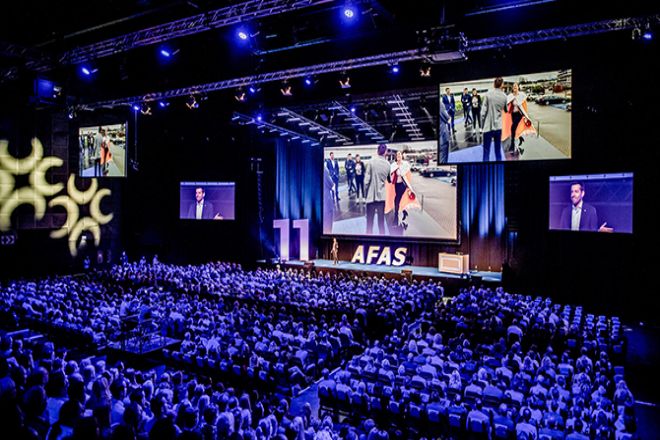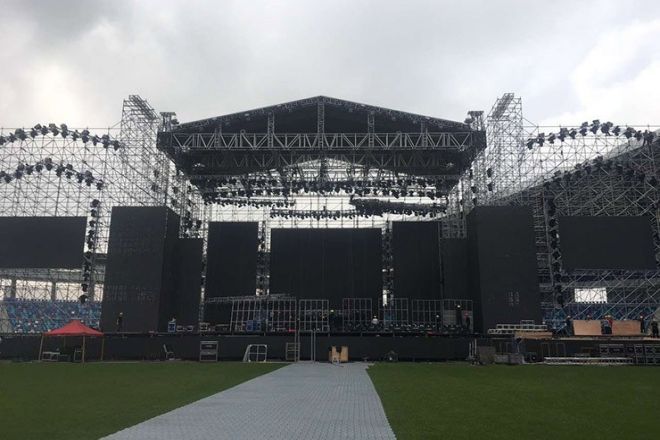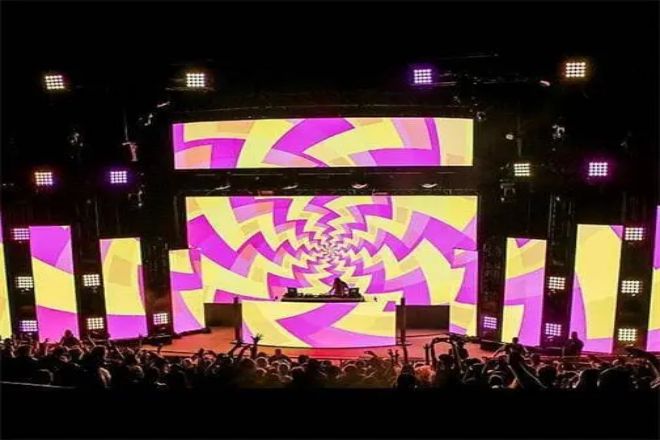Introducción

En el ámbito de las artes y actividades escénicas modernas, pantallas LED de escenario se han convertido en un elemento indispensable e importante. No sólo pueden atraer la atención de la audiencia con impactantes efectos visuales, sino que también pueden agregar posibilidades ilimitadas a las actividades a través de imágenes dinámicas, interacción en tiempo real y otras funciones.
Desde conciertos a gran escala hasta conferencias de prensa corporativas, desde teatros interiores hasta plazas al aire libre, la amplia aplicación de pantallas LED para escenarios no solo mejora la experiencia visual del evento sino que también enriquece enormemente la expresión del arte escénico.
Sin embargo, la construcción de pantallas LED para escenarios no es fácil. Implica tecnología de ingeniería compleja, medición dimensional precisa, instalación y depuración meticulosas y estrictas normas de seguridad.
Un proyecto exitoso de construcción de pantallas LED requiere no solo un equipo profesional y equipos avanzados, sino también atención al detalle y un profundo conocimiento de la tecnología.
1. Preparación preliminar

En la etapa inicial de la construcción de la pantalla LED del escenario, una preparación preliminar suficiente es la clave para garantizar el buen progreso del proyecto. El trabajo en esta etapa incluye principalmente la determinación de las necesidades y la planificación, así como la preparación de materiales y equipos.
1). Determinar las necesidades y planificar.
- Propósito claro:
Primero, es necesario determinar las funciones principales y mostrar el contenido de la pantalla LED según el tipo específico de evento (como conciertos a gran escala, lanzamientos de nuevos productos, exposiciones de arte, etc.).
Los diferentes tipos de actividades tienen diferentes requisitos en cuanto a la resolución, el brillo, la reproducción del color y otros parámetros de rendimiento de la pantalla.
- Inspección de sitio:
A continuación, se realizará una inspección detallada del lugar del evento. Esto incluye medir el tamaño, la altura y la capacidad de carga del escenario para garantizar que la instalación de la pantalla LED no exceda la capacidad de carga del escenario.
Al mismo tiempo, también es necesario comprender el suministro de energía, la red y otra infraestructura en el lugar para prepararse para el suministro de energía y la transmisión de datos de la pantalla.
- Plan de diseño:
Después de aclarar las necesidades y las condiciones del sitio, comience a diseñar el plan específico para la pantalla LED.
Esto incluye determinar las especificaciones de la pantalla de visualización (como el tamaño y la resolución de la pantalla), el diseño (como pantalla única, empalme de pantallas múltiples, arco o forma especial, etc.) y el método de elevación (como marco de elevación, conexión a tierra). apoyo, etcétera).
El plan de diseño debe considerar plenamente factores como el tema del evento, la perspectiva de la audiencia y los efectos visuales.
2). Preparación de materiales y equipos.
- Módulo de pantalla de visualización:
Seleccione el módulo de pantalla LED apropiado según el plan de diseño. Estos módulos son las unidades básicas que constituyen toda la pantalla y su calidad afecta directamente el efecto de visualización.
Al seleccionar, preste atención a los indicadores de rendimiento del módulo, como el brillo, la consistencia del color y el ángulo de visión.
- Soportes y equipos de fijación:
Prepare los soportes, vigas colgantes, bastidores de fijación y otros equipos de instalación correspondientes de acuerdo con el plan de diseño. Estos dispositivos deben tener alta resistencia y estabilidad para garantizar la seguridad de la pantalla durante la instalación y el uso.
- Sistema de control y suministro de energía:
Prepare suficientes cables de alimentación, tarjetas de control, cables de conexión, software de control, etc. Estos dispositivos son la clave para el funcionamiento normal de la pantalla; el suministro de energía debe ser estable y confiable, y el sistema de control debe ser potente y fácil de operar.
- Materiales auxiliares:
Prepare los materiales auxiliares necesarios, como tornillos, correas, plexiglás (utilizado para proteger la superficie de la pantalla o hacer marcos), marcos de acero inoxidable (para mejorar la estética general de la pantalla), etc. Estos materiales jugarán un papel importante en la instalación y depuración de la pantalla.
2. Pasos de construcción
Una vez completada la preparación preliminar de la pantalla LED del escenario, se ingresará a la etapa de construcción sustantiva. El trabajo en esta etapa requiere un funcionamiento fino y un control estricto de cada paso para garantizar la calidad de la instalación y el efecto final de la pantalla.
1). Soporte de instalación
- Fabricación de soportes:
De acuerdo con la situación real del sitio y los planos de diseño, fabrique o seleccione con precisión el soporte apropiado. El material, la estructura y la capacidad de carga del soporte deben cumplir con los requisitos de peso y seguridad de la pantalla para garantizar la estabilidad y confiabilidad.
- Soporte de instalación:
Seleccione una posición adecuada en el escenario y utilice herramientas profesionales para fijar el soporte en el suelo o en la estructura del escenario. Durante el proceso de instalación, se debe prestar especial atención al grado horizontal y vertical del soporte, y se deben utilizar herramientas como un nivel para realizar mediciones y ajustes precisos para garantizar la precisión de la instalación del soporte.
2). Montaje de la pantalla de visualización
- Instalación del módulo:
Coloque los módulos de pantalla LED en el soporte uno por uno según la disposición predeterminada.
Durante la instalación, es necesario asegurarse de que el espacio entre cada módulo sea uniforme y esté alineado con precisión y utilice tornillos u otras fijaciones para fijar firmemente el módulo en el soporte.
- Líneas de conexión:
Conecte el cable de alimentación, el cable de datos y la tarjeta de control en la pantalla. Durante el proceso de conexión es necesario comprobar cuidadosamente si los conectores de cada línea están firmes y no sueltos y evitar problemas como mal contacto o cortocircuito.
Al mismo tiempo, también es necesario prestar atención a la dirección y el diseño de la línea para garantizar que sea ordenada y hermosa y no afecte el efecto de visualización de la pantalla.
- Depuración preliminar:
Una vez instalado el módulo de pantalla y conectada la línea, se lleva a cabo el trabajo de depuración preliminar.
Envíe una señal a través del software de control para verificar si la pantalla se puede iluminar normalmente y observar si su efecto de visualización cumple con los requisitos esperados. Si hay un problema, es necesario comprobarlo y solucionarlo a tiempo.
3). Elevación y ajuste
- Selección del método de elevación:
Seleccione un método de elevación adecuado según el tamaño, el peso y las condiciones del sitio de la pantalla. Los métodos de elevación comunes incluyen el tipo de engranaje, el tipo de varilla cónica, el tipo de perno, etc., que deben seleccionarse según las circunstancias específicas.
- Operación de elevación:
Utilice equipo de elevación profesional (como una grúa, un polipasto, etc.) para levantar la pantalla a la posición predeterminada. Durante el proceso de elevación, la pantalla debe mantenerse equilibrada y estable para evitar colisiones o inclinación. Después de alcanzar la posición predeterminada, utilice cuerdas o fijaciones para fijar firmemente la pantalla al soporte.
- Ajuste de ángulo:
Ajuste el ángulo de instalación de la pantalla de visualización de acuerdo con las condiciones del lugar.
Esto incluye el ajuste del ángulo horizontal y el ángulo vertical para garantizar el mejor efecto de visualización de la pantalla. El ajuste se puede lograr usando un ajustador de ángulo o ajustando manualmente los tornillos en el soporte.
4). Instalación y depuración del sistema de control.
- Instale el dispositivo de control:
Inserte la tarjeta de control en la ranura para tarjeta de control de la pantalla y conéctela a una computadora u otro dispositivo de control. Al realizar la conexión, asegúrese de que la interfaz coincida, la conexión sea firme y correcta.
- Configuración del software:
Instale y configure el software de control de la pantalla LED. Configure los parámetros correspondientes como brillo, contraste, color, etc. según el modelo y especificaciones de la pantalla.
Al mismo tiempo, el software debe calibrarse y depurarse para garantizar que pueda controlar con precisión el efecto de visualización de la pantalla.
- Prueba funcional:
Una vez instalado y configurado el sistema de control, realice una prueba funcional. Reproduzca el vídeo o la imagen de prueba para comprobar el efecto de visualización y la estabilidad de la pantalla.
Observe si la imagen es clara, suave y no tiene defectos obvios; compruebe si la reproducción del color, la uniformidad del brillo y otros indicadores cumplen con los requisitos.
Al mismo tiempo, preste atención a si se produce algún fenómeno anormal (como parpadeo, pantalla negra, etc.) durante el funcionamiento de la pantalla. Si hay algún problema, debe comprobarse y solucionarse a tiempo.
3. Seguridad y mantenimiento

En la construcción, uso y posterior mantenimiento de la pantalla LED de escenario, la seguridad y el mantenimiento son dos aspectos cruciales. No sólo están relacionados con el funcionamiento estable y la vida útil prolongada del equipo, sino también directamente con la seguridad personal del personal en el sitio.
1). Precauciones de seguridad
- Especificaciones de operación:
Todo el personal involucrado en la construcción, depuración y uso debe cumplir estrictamente con los procedimientos operativos de seguridad.
Esto incluye usar equipo de protección adecuado (como cascos, guantes, calzado protector, etc.), usar herramientas profesionales y mantenerse concentrado y cauteloso durante la operación. Cualquier violación de las normas de seguridad debe detenerse y corregirse inmediatamente.
- Antivibración y anticaída:
La pantalla LED del escenario es susceptible a vibraciones e impactos durante el transporte y la instalación, por lo que debe tener un alto rendimiento antivibración.
Maneje la pantalla con cuidado durante el transporte para evitar vibraciones severas; Utilice equipos y accesorios de elevación profesionales durante la instalación para garantizar que la pantalla sea estable y confiable.
Además, se debe evitar una fuerza externa excesiva en la pantalla durante las fases de depuración y prueba.
- Evite tocar:
La superficie de la pantalla está cubierta con una gran cantidad de mechas LED, que son muy frágiles y sensibles a la electricidad estática.
Por lo tanto, durante las fases de depuración y prueba, intente evitar tocar la superficie de la pantalla para evitar daños a las mechas del LED o introducir interferencias estáticas.
Si se requieren operaciones necesarias, se deben utilizar herramientas y guantes profesionales, y las manos deben estar secas y libres de electricidad estática.
2). Mantenimiento y cuidado
- Inspección regular:
Para garantizar el funcionamiento estable de la pantalla y prolongar su vida útil, la pantalla debe inspeccionarse periódicamente. Esto incluye comprobar si las fijaciones de la pantalla (como tornillos, soportes, etc.) están sueltas o dañadas.
Comprobar si los cables de conexión (como cables de alimentación, cables de datos, etc.) están en buen contacto y sin daños; y comprobar si los distintos componentes de la pantalla funcionan normalmente. Si se encuentran problemas, se deben solucionar de manera oportuna y se deben reemplazar las piezas dañadas.
- Limpieza y mantenimiento:
El polvo y las manchas se acumulan fácilmente en la superficie y el interior de la pantalla, lo que no sólo afectará el efecto de la pantalla sino que también dañará el equipo. Por lo tanto, la superficie y el interior de la pantalla deben limpiarse periódicamente.
Al limpiar, debe utilizar agentes de limpieza profesionales y un paño suave para limpiar, y evitar el uso de agentes de limpieza que contengan sustancias corrosivas u objetos duros para rayar la superficie de la pantalla. Al mismo tiempo, también debes prestar atención a mantener el entorno alrededor de la pantalla limpio y seco para evitar la humedad y el moho.
- Manejo de fallas:
Si encuentra problemas comunes, como brillo desigual y fallas de píxeles durante el uso, debe solucionarlos a tiempo.
Primero, debe verificar la causa específica de la falla, como cables de conexión sueltos, mechas de LED dañadas, etc.; luego tome las medidas adecuadas según la situación específica para solucionarlo, como volver a conectar la línea, reemplazar las mechas LED dañadas, etc.
Si no puede manejarlo usted mismo, debe comunicarse con personal de mantenimiento profesional a tiempo para realizar el mantenimiento y garantizar que la pantalla pueda funcionar de manera estable durante mucho tiempo.
Conclusión
En resumen, la construcción de pantallas LED escénicas es un proyecto complejo y delicado, que requiere que seamos meticulosos en cada detalle. A través del análisis detallado de este artículo, comprendemos todo el proceso, desde la preparación preliminar hasta los pasos de construcción, la seguridad y el mantenimiento, y dominamos las tecnologías y precauciones clave para la construcción de pantallas LED para escenarios.
Finalmente, si quieres saber más sobre las pantallas LED, Por favor póngase en contacto con nosotros.
